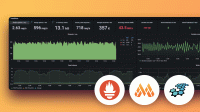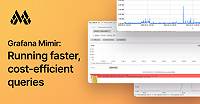Important: This documentation is about an older version. It's relevant only to the release noted, many of the features and functions have been updated or replaced. Please view the current version.
About Grafana Mimir dashboards and alerts requirements
Grafana Mimir dashboards and alerts require certain labels to exist on metrics scraped from Grafana Mimir.
The mimir-distributed Helm chart provides metamonitoring support, which takes care of these labels.
For more information about Helm chart metamonitoring, refer to Collect metrics and logs via the Helm chart.
If you are using Helm chart metamonitoring, go to Installing Grafana Mimir dashboards and alerts.
If you are not, then continue reading. Your Prometheus or Grafana Agent must be configured to add these labels in order for the dashboards and alerts to function. The following table shows the required label names and whether they can be customized when compiling dashboards or alerts from sources.
| Label name | Configurable? | Description | |
|---|---|---|---|
cluster | Yes | The Kubernetes cluster or datacenter where the Mimir cluster is running. You can configure the cluster label via the per_cluster_label field in the mixin configuration. | |
namespace | Yes | The Kubernetes namespace where the Mimir cluster is running. You can configure the namespace label via the per_namespace_label field in the mixin configuration. | |
job | Yes | A prefix (by default <namespace>/) followed by the Mimir component. When running in monolithic mode, make sure that the <component> is mimir. When running in microservices mode, make sure that the <component> is the name of the specific Mimir component (singular), such as distributor, ingester, or store-gateway. Similarly, in read-write mode, make sure the <component> is either mimir-read, mimir-write, or mimir-backend. In the mixin configuration, you can configure the prefix via the job_prefix field, the label name via the per_job_label field, and the regular expressions that are used to match components via the job_names field. | |
pod | Yes | The unique identifier of a Mimir replica, for example the Pod ID when running on Kubernetes. You can configure the instance label via the per_instance_label field in the mixin configuration. | |
instance | Yes | The unique identifier of the node or machine where the Mimir replica is running, for example the node when running on Kubernetes. You can configure the node label via the per_node_label field in the mixin configuration. |
For rules and alerts to function properly, you must configure your Prometheus or Grafana Agent to scrape metrics from Grafana Mimir at an interval of 15s or shorter.
Deployment type
By default, Grafana Mimir dashboards assume Mimir is deployed in containers orchestrated by Kubernetes.
If you’re running Mimir on baremetal, set the configuration field deployment_type: 'baremetal' and re-compile the dashboards.
Job selection
A metric could be exposed by multiple Grafana Mimir components, or even different applications running in the same namespace.
To provide accurate dashboards and alerts, the job label (by default job) selects a metric from specific components.
A job is a combination of a prefix and component. The default prefix is the Kubernetes namespace followed by a slash, for example <namespace>/ in <namespace>/ingester.
Pre-compiled dashboards and alerts are shipped with a default configuration.
If you compile dashboards and alerts from source, you have the option to customize a) the label used for the job selection via the per_job_label field, b) the prefix expected in the label value, which you can omit by setting it to '' via the job_prefix field, and c) the regular expression used to select each Mimir component via the job_names field in the mixin configuration.
Default job selection in monolithic mode
When running Grafana Mimir in monolithic mode and using the pre-compiled dashboards and alerts, the job label should be set to <namespace>/mimir.
Default job selection in microservices mode
When running Grafana Mimir in microservices mode and using the pre-compiled dashboards and alerts, the job label should be set according to the following table.
| Mimir service | Expected job label |
|---|---|
| Distributor | <namespace>/distributor |
| Ingester | <namespace>/ingester |
| Querier | <namespace>/querier |
| Ruler | <namespace>/ruler |
| Query-frontend | <namespace>/query-frontend |
| Query-scheduler | <namespace>/query-scheduler |
| Store-gateway | <namespace>/store-gateway |
| Compactor | <namespace>/compactor |
Default job selection in read-write mode
When running Grafana Mimir in read-write mode and using the pre-compiled dashboards and alerts, set the job label accordingly:
| Mimir service | Expected job label |
|---|---|
| Mimir Read | <namespace>/mimir-read |
| Mimir Write | <namespace>/mimir-write |
| Mimir Backend | <namespace>/mimir-backend |
Additional resources metrics
The Grafana Mimir dashboards displaying CPU, memory, disk, and network resources utilization require Prometheus metrics scraped from the following endpoints:
For more information about the kubelet metrics and cAdvisor metrics exported by the kubelet, refer to Metrics For Kubernetes System Components.
Metrics from kubelet, kube-state-metrics, and cAdvisor must all have a cluster label with the same value as in the
Mimir metrics.
Metrics from node_exporter must all have an instance label on them that has the same value as the instance label on Mimir metrics.
Log labels
The Slow queries dashboard uses a Loki data source with the logs from Grafana Mimir to visualize slow queries. The query-frontend component logs slow queries based on how you configured the -query-frontend.log-queries-longer-than parameter.
These logs need to have specific labels in order for the dashboard to work.
| Label name | Configurable? | Description |
|---|---|---|
cluster | Yes | The Kubernetes cluster or datacenter where the Mimir cluster is running. You can configure the cluster label via the per_cluster_label field in the mixin configuration. |
namespace | No | The Kubernetes namespace where the Mimir cluster is running. |
name | No | Name of the component. For example, query-frontend. |



